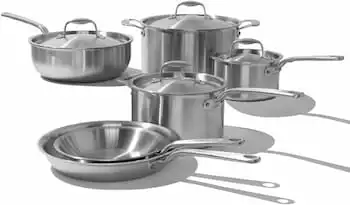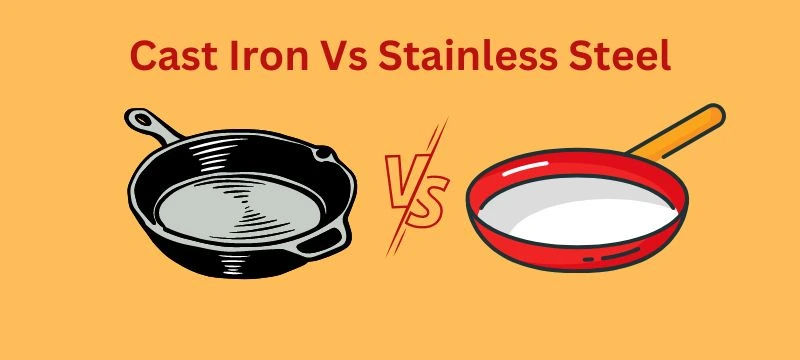Cast Iron vs Stainless Steel Cookware: Unveiling the Battle of the Titans
No matter the cuisine, style of cooking, or type of meal, the cookware material you prepare the food on is one of the most important aspects. With the growing needs of the ever-changing society and in light of the modern age, there have been several revolutionized cookware materials and the creation of new ones. Most people, although, prefer the classics – the originals – with refined and ingenious touch to it.
Stainless steel and cast-iron are some of the oldest means of cookware and have been subjected to consumer loyalty by people worldwide, rightfully so. Stainless steel does not rust, crack, or chip and has a smooth surface for the non-stick feature when cooking.
Cast iron is known to be one of the most durable cookware materials, which has lifespan longevity that can last up to several decades if maintained properly. To find which of these two will be the better fit for you, here is a guide for help.
Let’s compare both materials hand in hand and try to know the pros and cons of both cookware materials so you will be able to make an informed decision when selecting one.
Cast Iron Vs Stainless Steel Cookware: Comparison Table
Below is the comparison chart between Cast Iron Vs Stainless Steel:
| Cast Iron | Stainless Steel | |
| Safety | It emits iron boost with prolonged use and is reactive to certain foods | Has no coating to chip away and contaminate food, is entirely non-reactive |
| Heat-Conductivity | Avails relatively good heat conductivity retains heat for a long time | Tri-ply of 5-ply stainless steel cookware offers great heat conductivity with even distribution |
| Non-stick coating | With proper due seasoning, the surface gives a partial non-stick feature | Smooth surface for partial non-stick feature, but not meant for cleaning |
| Durability | Highly durable and capable of pertaining robust use while lasting for decades, or a lifetime | It can sustain robust use, does not rust, chip, or crack |
| Maintenance | Requires extensive and proper maintenance for the seasoning of the surface | Needs to be seasoned on few occasions, can be washed with ease |
| Weight | Heavy to Lift | Lightweight |
| Price | It falls on the relatively expensive spectrum; proves to be a lifelong investment | It falls somewhere between expensive and slightly inexpensive |
Cast Iron Cookware

Cast-iron is an age-old cookware material that has followed almost the same process of being created with the iron alloy with 2-4% of carbon content. This alloy, when molten, is poured into a mold to take the shape of a skillet or a pan – then, after being extracted, the cookware is blasted, refined, polished, rinsed, and sometimes seasoned with a coating of enamel for smoothening of the uppermost layer.
Because of how durable and sturdy this material is, cast-iron cookware can last up to several decades and can even be passed down to generations through a lifetime. This allows you to avoid investing in multiple pans every time one gets ruined and serves as a good incentive for sustainability concerning added environmental waste.
There have been concerns about the iron boost with cooking meals on the cast-iron cookware, which several studies have backed up. The matter is that it completely depends on the amount of time you are cooking for, resulting in a higher iron boost. A little number of nutrients will benefit your health.
Pros
Cons
Usages of Cast Iron Cookware
Searing and Browning: Cast iron’s ability to reach high temperatures makes it perfect for achieving a beautiful sear on meats and vegetables, creating caramelization and enhancing flavors.
Slow Cooking
The excellent heat retention of cast iron makes it ideal for slow-cooking dishes like stews, braises, and roasts. It ensures even and gentle heat distribution over extended periods, resulting in tender and flavorful meals.
Baking
Cast iron cookware can be used for baking dishes such as cornbread, cobblers, and even pizzas. Its ability to hold heat evenly throughout the cooking process helps achieve a golden and crispy crust.
About Stainless Steel Cookware

Like cast-iron, stainless steel also constitutes a small amount of carbon – less than 2% of carbon alloy. It is mostly made with naturally occurring elements and is, therefore, safe for use.
Usually, there is no additive coating for the smoothened surface of the stainless steel non-stick feature, eliminating the worry of having chipped away substances contaminate your food being cooked in it.
This cookware material is lightweight and sleek – which avails swift and easy maneuvering when preparing a meal. Moreover, stainless steel is one of the bests for browning your food to perfection, sautéing, and boiling. It works great for people who are extensively indulging in cooking proper portions of food. It is non-reactive and non-toxic, which helps in providing a healthy and hearty meal.
Although the surface of the stainless steel cookware is smooth, it is not entirely non-stick. So, when stubborn and sticky food refuses to leave the cookware, it may become difficult to scrub it off. Regardless, stainless steel does not require a lot of maintenance or extensive seasoning like cast-iron does.
Pros
Cons
Usages of Stainless Steel Cookware
Stainless steel cookware is suitable for a wide range of cooking techniques. From searing meats and sautéing vegetables to simmering sauces and boiling pasta, stainless steel pans and pots can handle it all.
Its ability to tolerate high temperatures makes it ideal for tasks that require intense heat, such as achieving a perfect sear on a steak or creating a crispy stir-fry.
Cast Iron Vs Stainless Steel: The Similarities And Differences
1. Safety
The major concern with cast-iron cookware is that it emits iron boost when used for a prolonged period – which several studies have backed up. For regular use, small portions of iron will only serve as nutrients with a slight change in taste and nothing else – unless you have a specific disorder that will be harmful to iron. It is also reactive to certain food items and will rust if in contact with water for a long time.
Stainless steel is non-reactive and non-toxic, with almost no emission of anything of sorts. It causes no harm to your body, as it does not have a coating that will chip away and contaminate your food. Moreover, it is completely okay to cook all sorts of food items in it.
2. Heat-Conductivity
Cast-iron can retain great levels of heat without suffering from any repercussions. It is, therefore, highly preferred for oven use like baking, roasting, and such. Adding to this, cast iron cookware is also great for retaining the heat that it has acquired for a good time, even when the heat source is gone.
A tri-ply or 5-ply stainless steel cookware will provide better heat conductivity and distribute the heat evenly within the food being cooked in the pan or pot. Stainless steel cookware can also handle high temperatures of heat, but not as much as cast-iron.
3. Non-Stick Coating
The best part about cast-iron cookware is that it gets better with each use. It needs to be seasoned regularly with proper care – which may seem taxing, but it will prove to be of great benefit when you do not have to buy a pan or skillet every two years. Whenever you use your cast-iron cookware, you are helping its surface sustain its partially non-stick smooth quality.
Stainless steel is naturally a smooth substance when refined and polished into cookware. It is, therefore, offering a partially non-stick feature merely because of the smoothness of the surface. Because of this, the food that gets stuck on it will have to be scrubbed clean vigorously.
4. Durability
Cast-iron is one of the most durable and long-lasting cookware materials available. This feature is the main reason, for several people, to invest in cast-iron. When maintained and seasoned properly, a cared-for cast iron cookware can last a lifetime and be passed down from generation to generation. It can handle robust use and sustain all its usability. This material can rust if it gets in contact with water too often.
Stainless steel is a material that does not rust, crack, or chip – neither does it stain if used with extensive care. Due to this, stainless steel is highly durable and lasts long. It is lightweight but can handle robust use while availing easy maneuvering.
5. Maintenance
The maintenance of cast-iron takes a lot of time and effort – but it proves to be highly worth it, as this cookware will last you a lifetime. Almost like a one-time investment, cast-iron cookware needs to be taken care of properly for you to enjoy it forever. Washing it with soap is ill-advised, as it can rust.
Stainless steel requires much less maintenance as compared to cast-iron. It does not rust and can, therefore, be washed with soap and water. Although, there is a need to season its surface as well – because there is no external coating – and retain the smoothness of the natural stainless steel surface.
6. Price
Cast-iron falls on the expensive spectrum of the cookware materials as it is a long process put behind the work of molding cast-iron cookware. But, regardless of its price, several consumers of this cookware material have conveyed how completely worth the investment is. Rather than buying a pan or skillet every two years, a cast-iron pan or skillet will last for a lifetime with proper care.
Stainless steel proves to be neither too expensive nor too inexpensive when compared with cast-iron. Although, it certainly cannot be considered as one of the cheaper cookware materials. Despite its price, stainless steel is durable and also a good investment.
7. Weight
Cast iron cookware is significantly heavier than stainless steel, which can make handling and maneuvering challenging, especially for those with limited strength or mobility.
Stainless steel cookware is comparatively lighter, making it easier to lift and handle.
Cast Iron Vs Stainless Steel: Which Cookware Should You Choose?
There are many different cuisines and types of meals that all require their respective cooking styles. It is, therefore, not possible to choose the best out of stainless steel and cast-iron. Each of these two cookware materials has its benefits and limitations – they avail their individual and unique features that cater to different people.
For people who wish to invest in one-time cookware – mostly a pan or skillet – and are not opposed to extensive maintenance, cast-iron is best suited for them. On the other hand, for people who wish to have lightweight, easy to clean, non-reactive cookware, stainless steel is best suited.

